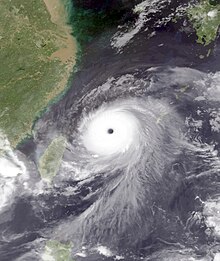
Back Taifun Saomai (2006) German Tifón Saomai Spanish Typhon Saomai French Topan Saomai ID 平成18年台風第8号 Japanese 태풍 사오마이 (2006년) Korean Tufão Saomai Portuguese Саомай (тайфун) Russian 颱風桑美 (2006年) Chinese Hong-thai Saomai (2006 nî) ZH-MIN-NAN
 Typhoon Saomai near peak intensity on August 9 | |
| Meteorological history | |
|---|---|
| Formed | August 4, 2006 |
| Extratropical | August 11, 2006 |
| Dissipated | August 12, 2006 |
| Violent typhoon | |
| 10-minute sustained (JMA) | |
| Highest winds | 195 km/h (120 mph) |
| Lowest pressure | 925 hPa (mbar); 27.32 inHg |
| Category 5-equivalent super typhoon | |
| 1-minute sustained (SSHWS/JTWC) | |
| Highest winds | 260 km/h (160 mph) |
| Lowest pressure | 898 hPa (mbar); 26.52 inHg |
| Overall effects | |
| Fatalities | 456 total |
| Damage | $2.5 billion (2006 USD) |
| Areas affected | Mariana Islands, Taiwan, China |
| IBTrACS / [1] | |
Part of the 2006 Pacific typhoon season | |
Typhoon Saomai, known in the Philippines as Super Typhoon Juan, was considered the most powerful typhoon on record to strike the east coast of the People's Republic of China. It was the eighth tropical storm, fifth typhoon, and third super typhoon of the 2006 Pacific typhoon season recognized by the Joint Typhoon Warning Center. According to the Japan Meteorological Agency, Saomai was the seventh tropical storm and fifth typhoon of the season. The name "Saomai" was submitted by Vietnam, and is from the Vietnamese word for "morning star" (sao Mai), a reference to the planet Venus.[2]
The typhoon brought heavy rain and wind to areas of the Mariana Islands, the Philippines, Taiwan, and the east coast of China. It was responsible for 456 deaths and $2.5 billion (2006 USD) in damage. Saomai affected many of the same areas affected by Tropical Storm Bilis a month earlier, and the China Meteorological Administration reported that Saomai was the strongest typhoon that ever occurred over China's offshore region as well as the most powerful typhoon ever to make landfall over Mainland China.[3]
- ^ Typhoon Committee (2006-12-04). "Review of the 2006 Typhoon Season". World Meteorological Organization. Archived from the original (DOC) on 2007-08-09.
- ^ "List of names for tropical cyclones adopted by the Typhoon Committee for the western North Pacific Ocean and the South China Sea". RSMC Tokyo — Typhoon Center. Archived from the original on December 12, 2009. Retrieved August 11, 2006.
- ^ Duan Yihong. "Why were the impacts of Bilis and Saomai so severe?". China Meteorological Administration. Archived from the original (PDF) on 2008-03-07. Retrieved 2006-12-01.